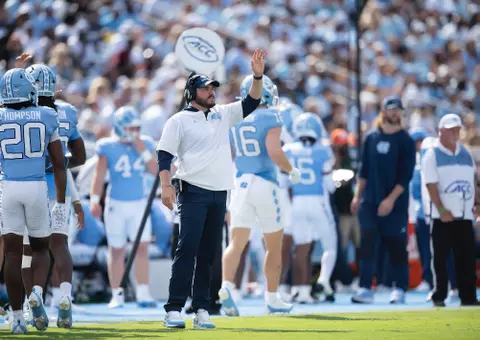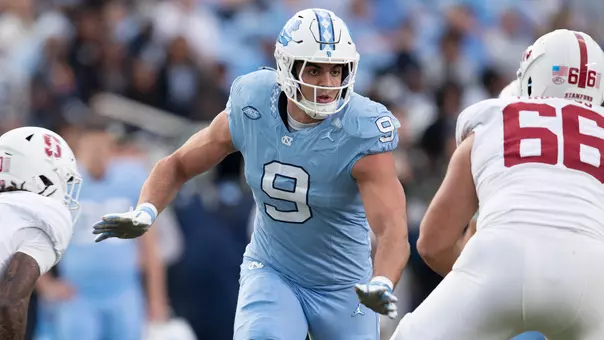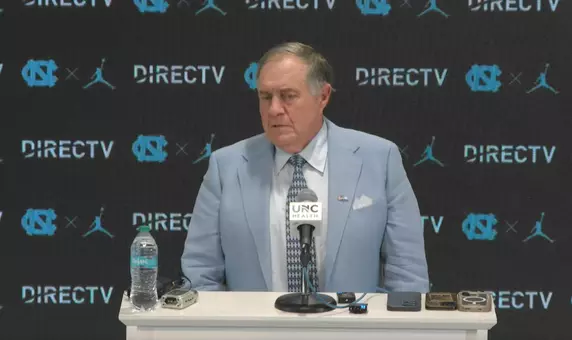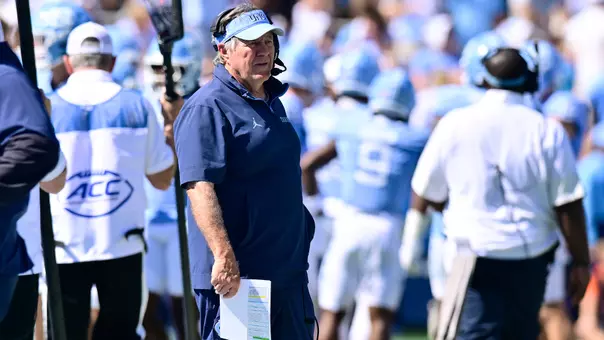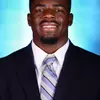University of North Carolina Athletics
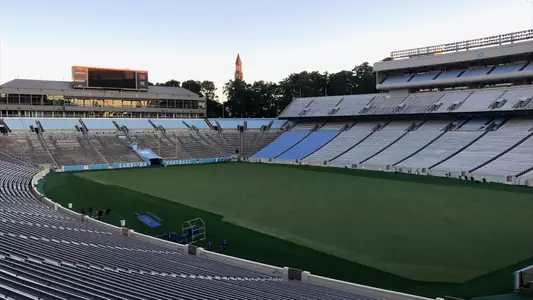
Extra Points: Change Of Venue
August 1, 2017 | Football, Featured Writers, Lee Pace
by Lee Pace
It was roughly one-quarter of a mile from the old Kenan Field House, across the Rams Head parking lot, up Ridge Road to the entry to Navy Field practice complex which Tar Heel football players and coaches had to tread before and after every football practice. The walk became slightly longer when the football headquarters moved in 1998 to the west end zone of Kenan Stadium, and the preferred pathway then evolved to exiting the North Gate of the stadium, walking along Stadium Drive, cutting in back of Teague dorm and entering the practice area through a back gate.
Mack Brown used ride from his office to the practice field in the BMW of close friend Dick Coop, a professor of educational psychology at UNC who was a consultant on the mental aspects of the team and attended every practice. John Bunting bought a bicycle to get some exercise on the short jaunt. Butch Davis commandeered a golf cart. Larry Fedora in the beginning rode a golf cart but then thought that looked soft to his players and took to walking over and back—just as his players had to.
There's the celebrated story of one player in the mid-1970s getting into a scuffle with an assistant coach and being summarily banished from the team by Coach Bill Dooley. The player began disrobing as he walked back to the field house, managers picking up his helmet, jersey and pads along the way.
"I can still see him with nothing on but a jock strap while he walked away out the gate back to Kenan," says one player who was there.
These nuances and vagaries of running training camp and three practices a week on a separate part of campus take a one-year hiatus beginning Wednesday when the 2017 Tar Heels convene for August training camp. Since the conclusion of World War II, Carolina's football team has practiced on the field to the southeast of Fetzer Field built by the Navy during its massive presence on campus during the war.
But the football practice facility and adjacent venues for soccer, lacrosse, track and field hockey are now one massive construction site—the so-called "South Campus Sports Complex" that is costing upwards of $100 million—forcing major logistical, transportation and agronomic challenges to the entire Carolina Athletic Department. From now until its new Football Practice Complex opens in one year, Fedora and his team will practice in Kenan Stadium during the week, then play there on seven Saturdays in the fall.
"I think it will work fine, I'm looking forward to it," says linebacker Andre Smith. "Sometimes the way you feel before practice is different from how you feel after practice. That walk back can be a little dicey sometimes. And we'll be in Kenan all the time. One reason I came to Carolina was to play in Kenan."
An array of permanent and/or heavy practice equipment has been moved from Navy Field to the stadium—including 10 blocking sleds mounted on concrete bases sunk six feet into the ground, a variety of movable sleds used by different position groups, large trash barrels, throwing nets, chutes of different sizes and configurations, and dummies used for agility and tackling, just to name a few. The smaller pieces will be moved to a storage room on the ground floor of the Loudermilk Center on weekends, the large ones like the seven-man blocking sled carted off on a trailer to an off-campus facility on Thursday nights and brought back Monday mornings.
The tarmac, fence and hedges surrounding the playing field have been removed and a custom-designed Field Turf installed around the perimeter of the game field, which has been sodded with Latitude 36 Bermuda grass. That gives the football team 90,000 square feet for practice, compared to the nearly 200,000 it used to have between two standard practice fields and adding the field hockey venue for kicking practice.
Fedora and his coaches will have the option of operating on the standard game field for scrimmages and of breaking into two fields set perpendicular, or running north-across across the short end of the field—one for offense, one for defense, about 40 yards long each with an end zone.
"There's been a lot of planning, a lot of talk over nearly two years," says Casey Carrick, director of athletic grounds and turf management. "One thing everyone agreed on was that we wanted to stay on grass if we could. Taking out the hedges has not been popular, but we had to do that to get the space we need. The team will do as many drills as possible on the turf to save the grass. Then every Thursday before a home game, we're prepared to re-sod if needed. Our priorities are safety and playability. I think we've planned for every contingency."
Carolina Green Corporation, headquartered in Indian Trail, just east of Charlotte, handles turf installation for many major venues, including Kyle Field at Texas A&M, Williams-Brice Stadium in Columbia and Lincoln Financial Field of the NFL's Philadelphia Eagles. The company has a half-million square feet of Bermuda sod that it planted in March, ready to be cut, rolled and transported to Chapel Hill.
"This stuff is 17 pounds a square foot and is an inch and a half thick," Carrick says. "They lay it down and it's not moving anywhere. They can install it in the rain and it'll be ready to go. Now, we don't need another Hurricane Matthew, but other than that, we should be fine."
Fedora and his coaches spent a large chunk of their day Monday thinking through logistics of running practices in a confined place. If you're running 7-on-7 on the perpendicular half-field, where are the video cameras positioned? Where are the players not in the game in a full team drill positioned so they can hear the coaches? Where do the kickers go given they normally had half a field free with a goal post at Navy Field? And how can the offense take deep shots down the field if there's not enough room on the half-fields and the defense is occupying the far half of the standard game field?
"It's not an ideal situation, but we'll make it work," Fedora says. "We have no other choice."
"It will be a challenge," Carrick adds, "but everyone understands the big picture, the end game. It will be well worth it."
Lee Pace enters his 28th year covering Tar Heel football through "Extra Points," which appears throughout the year. He'll also report from the sidelines for the Tar Heel Sports Network. Email him at leepace7@gmail.com and follow him on Twitter @LeePaceTweet.
It was roughly one-quarter of a mile from the old Kenan Field House, across the Rams Head parking lot, up Ridge Road to the entry to Navy Field practice complex which Tar Heel football players and coaches had to tread before and after every football practice. The walk became slightly longer when the football headquarters moved in 1998 to the west end zone of Kenan Stadium, and the preferred pathway then evolved to exiting the North Gate of the stadium, walking along Stadium Drive, cutting in back of Teague dorm and entering the practice area through a back gate.
Mack Brown used ride from his office to the practice field in the BMW of close friend Dick Coop, a professor of educational psychology at UNC who was a consultant on the mental aspects of the team and attended every practice. John Bunting bought a bicycle to get some exercise on the short jaunt. Butch Davis commandeered a golf cart. Larry Fedora in the beginning rode a golf cart but then thought that looked soft to his players and took to walking over and back—just as his players had to.
There's the celebrated story of one player in the mid-1970s getting into a scuffle with an assistant coach and being summarily banished from the team by Coach Bill Dooley. The player began disrobing as he walked back to the field house, managers picking up his helmet, jersey and pads along the way.
"I can still see him with nothing on but a jock strap while he walked away out the gate back to Kenan," says one player who was there.
These nuances and vagaries of running training camp and three practices a week on a separate part of campus take a one-year hiatus beginning Wednesday when the 2017 Tar Heels convene for August training camp. Since the conclusion of World War II, Carolina's football team has practiced on the field to the southeast of Fetzer Field built by the Navy during its massive presence on campus during the war.
But the football practice facility and adjacent venues for soccer, lacrosse, track and field hockey are now one massive construction site—the so-called "South Campus Sports Complex" that is costing upwards of $100 million—forcing major logistical, transportation and agronomic challenges to the entire Carolina Athletic Department. From now until its new Football Practice Complex opens in one year, Fedora and his team will practice in Kenan Stadium during the week, then play there on seven Saturdays in the fall.
"I think it will work fine, I'm looking forward to it," says linebacker Andre Smith. "Sometimes the way you feel before practice is different from how you feel after practice. That walk back can be a little dicey sometimes. And we'll be in Kenan all the time. One reason I came to Carolina was to play in Kenan."
An array of permanent and/or heavy practice equipment has been moved from Navy Field to the stadium—including 10 blocking sleds mounted on concrete bases sunk six feet into the ground, a variety of movable sleds used by different position groups, large trash barrels, throwing nets, chutes of different sizes and configurations, and dummies used for agility and tackling, just to name a few. The smaller pieces will be moved to a storage room on the ground floor of the Loudermilk Center on weekends, the large ones like the seven-man blocking sled carted off on a trailer to an off-campus facility on Thursday nights and brought back Monday mornings.
The tarmac, fence and hedges surrounding the playing field have been removed and a custom-designed Field Turf installed around the perimeter of the game field, which has been sodded with Latitude 36 Bermuda grass. That gives the football team 90,000 square feet for practice, compared to the nearly 200,000 it used to have between two standard practice fields and adding the field hockey venue for kicking practice.
Fedora and his coaches will have the option of operating on the standard game field for scrimmages and of breaking into two fields set perpendicular, or running north-across across the short end of the field—one for offense, one for defense, about 40 yards long each with an end zone.
"There's been a lot of planning, a lot of talk over nearly two years," says Casey Carrick, director of athletic grounds and turf management. "One thing everyone agreed on was that we wanted to stay on grass if we could. Taking out the hedges has not been popular, but we had to do that to get the space we need. The team will do as many drills as possible on the turf to save the grass. Then every Thursday before a home game, we're prepared to re-sod if needed. Our priorities are safety and playability. I think we've planned for every contingency."
Carolina Green Corporation, headquartered in Indian Trail, just east of Charlotte, handles turf installation for many major venues, including Kyle Field at Texas A&M, Williams-Brice Stadium in Columbia and Lincoln Financial Field of the NFL's Philadelphia Eagles. The company has a half-million square feet of Bermuda sod that it planted in March, ready to be cut, rolled and transported to Chapel Hill.
"This stuff is 17 pounds a square foot and is an inch and a half thick," Carrick says. "They lay it down and it's not moving anywhere. They can install it in the rain and it'll be ready to go. Now, we don't need another Hurricane Matthew, but other than that, we should be fine."
Fedora and his coaches spent a large chunk of their day Monday thinking through logistics of running practices in a confined place. If you're running 7-on-7 on the perpendicular half-field, where are the video cameras positioned? Where are the players not in the game in a full team drill positioned so they can hear the coaches? Where do the kickers go given they normally had half a field free with a goal post at Navy Field? And how can the offense take deep shots down the field if there's not enough room on the half-fields and the defense is occupying the far half of the standard game field?
"It's not an ideal situation, but we'll make it work," Fedora says. "We have no other choice."
"It will be a challenge," Carrick adds, "but everyone understands the big picture, the end game. It will be well worth it."
Lee Pace enters his 28th year covering Tar Heel football through "Extra Points," which appears throughout the year. He'll also report from the sidelines for the Tar Heel Sports Network. Email him at leepace7@gmail.com and follow him on Twitter @LeePaceTweet.
Players Mentioned
Hubert Davis Post-Georgetown Press Conference
Monday, December 08
Carolina Insider: Rapid Reactions – Men’s Basketball vs. Georgetown – December 7, 2025
Monday, December 08
UNC Men's Basketball: Wilson & Veesaar Lead 81-61 Win Over Hoyas
Monday, December 08
UNC Women's Basketball: Tar Heels Take Down Terriers, 82-40
Sunday, December 07












